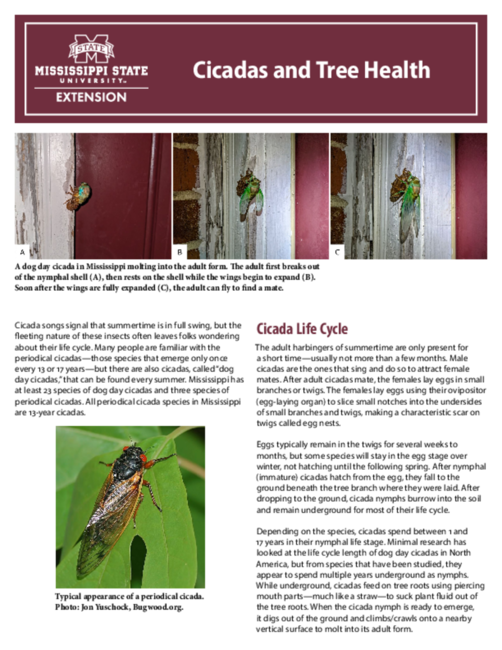P4122
Cicadas and Tree Health
Cicada songs signal that summertime is in full swing, but the fleeting nature of these insects often leaves folks wondering about their life cycle. Many people are familiar with the periodical cicadas—those species that emerge only once every 13 or 17 years—but there are also cicadas, called “dog day cicadas,” that can be found every summer. Mississippi has at least 23 species of dog day cicadas and three species of periodical cicadas. All periodical cicada species in Mississippi are 13-year cicadas.


Cicada Life Cycle
The adult harbingers of summertime are only present for a short time—usually not more than a few months. Male cicadas are the ones that sing and do so to attract female mates. After adult cicadas mate, the females lay eggs in small branches or twigs. The females lay eggs using their ovipositor (egg-laying organ) to slice small notches into the undersides of small branches and twigs, making a characteristic scar on twigs called egg nests.
Eggs typically remain in the twigs for several weeks to months, but some species will stay in the egg stage over winter, not hatching until the following spring. After nymphal (immature) cicadas hatch from the egg, they fall to the ground beneath the tree branch where they were laid. After dropping to the ground, cicada nymphs burrow into the soil and remain underground for most of their life cycle.
Depending on the species, cicadas spend between 1 and 17 years in their nymphal life stage. Minimal research has looked at the life cycle length of dog day cicadas in North America, but from species that have been studied, they appear to spend multiple years underground as nymphs. While underground, cicadas feed on tree roots using piercing mouth parts—much like a straw—to suck plant fluid out of the tree roots. When the cicada nymph is ready to emerge, it digs out of the ground and climbs/crawls onto a nearby vertical surface to molt into its adult form.
Tree Health Impacts
Cicadas are only minimally harmful to tree health. Although cicadas feed on trees as larvae and adults, they are not typically damaging enough to be considered pests. In other words, they do cause damage, but it is usually superficial and insufficient to hurt the overall health of the tree. In large emergence years, such as when periodical cicadas emerge, damage from cicadas can be more noticeable. However, it is still typically not severe enough to cause actual harm to tree health. Symptoms of cicada damage in these years—leaves turning brown and flagging—will often be seen at the tips of branches, typically of hardwood trees.
Small groups of flagging, dead leaves can be seen throughout the canopies. However, trees should be able to recover from this damage since most of the tree crown is intact and the disturbance is not prolonged. Cicadas may more heavily impact small nursery or young landscape trees because they are not yet established and many of their main branches are still small enough in diameter for cicadas to lay eggs in. Still, death typically does not result from cicada damage in these trees.
Reduced growth rate, altered canopy shape, and localized branch dieback may occur, but as long as the tree is otherwise healthy, it is likely to recover fully. Branches of landscape trees of concern can be wrapped with a thick material, such as burlap, to discourage egg laying while adult cicadas are active. For small trees, drape fine mesh over the entire canopy and secure it around the trunk of the tree to completely exclude cicadas from the tree canopy. For best results, install netting before cicadas begin emerging and keep it in place until they are no longer active.
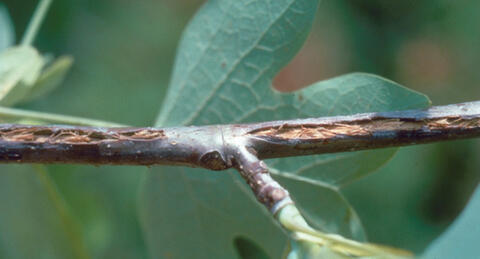
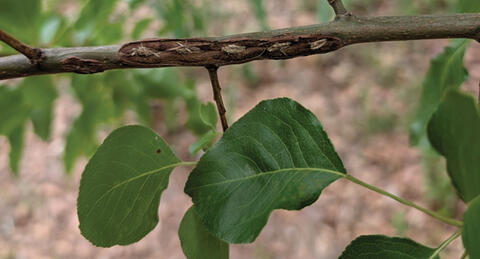
Although flagging from cicada damage can be unsightly, it will not remain on the affected trees long. The first windstorm after damage occurs will knock many flagging branches out of the canopy, with subsequent storms blowing the rest out. These branches can be raked up if they are in a landscape area, or they can be left to decompose because they pose no threat to tree health.
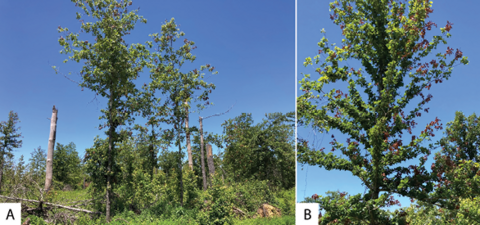
Periodical Cicadas
Mississippi has three species of cicadas that emerge periodically. The timing of these emergences depends on which brood they belong to. Periodical cicadas tend to emerge every 13 or 17 years (depending on their location) in large, defined groups known as “broods.” These mass emergences often include multiple species of periodical cicadas, and there may be more than one brood in a single location—each usually emerging in different years.
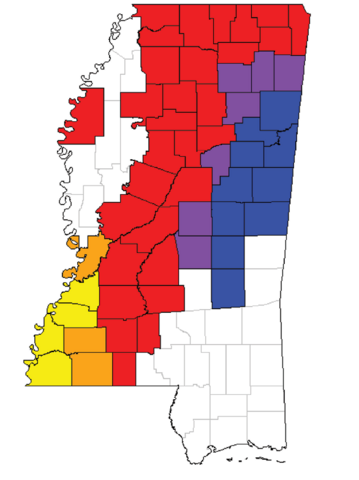
There are 15 broods in the eastern United States. Three broods are found in Mississippi: Brood XIX, Brood XXII, and Brood XXIII (all three have a 13-year emergence cycle). Brood XIX emerged most recently in 2024 and should emerge again in 2037. Brood XXII’s subsequent emergence will be in 2027, and Brood XXIII in 2028. It is not uncommon for small numbers of periodical cicadas to emerge a year or two early or late.
Differentiating Between Periodical and Dog Day Cicadas
Periodical and dog day cicadas can be differentiated from one another most easily by their physical appearance. Periodical cicadas have bright red eyes. Although they are cream-colored when they first molt from their shells, eventually periodical cicadas have almost entirely black bodies. The veins on their transparent wings sometimes have an orange/red hue. Dog day cicada coloration in Mississippi varies, but common cicadas typically have gray to black eyes, dark green to gray/black bodies, and black, gray, or orangish-red markings.
Summary
Cicadas rely on trees in every stage of their life cycle. However, their feeding rarely causes significant damage, and the most apparent damage is associated with adult cicadas laying eggs in branches. Periodical cicadas are especially notable because they emerge in great numbers simultaneously and can cause localized branch dieback on trees. Valuable ornamental and fruit trees can be protected from egg nest damage by wrapping branches or netting to deter cicadas from laying eggs. Although they periodically cause unsightly damage, these insects are a natural wonder. There are other periodical cicada species in the world, but North America has the longest-lived ones. Some other species live for 4 to 8 years, but none come close to North America’s 13- and 17-year broods.
References
Alexander, R., & Moore T. (1958). Studies on the acoustical behaviour of seventeen-year cicadas (Homoptera: Cicadidae: Magicicada). Ohio Journal of Science, 58, 107–127.
Hill, K. B. R., Marshall, D. C., Moulds, M. S., & Simon, C. (2015). Molecular phylogenetics, diversification, and systematics of Tibicen Latreille 1825 and allied cicadas of the tribe Cryptotympanini, with three new genera and emphasis on species from the USA and Canada (Hemiptera: Auchenorrhyncha: Cicadidae). Zootaxa, 3985(2), 219–251.
Karban, R. (2022). Why cicadas (Hemiptera: Cicadidae) develop so slowly. Biological Journal of the Linnean Society, 135(2), 291–298.
Koenig, W. D., Ries, L., Olsen, V. B. K., & Liebhold, A. M. (2011). Avian predators are less abundant during periodical cicada emergences, but why? Ecology, 92(3), 784–790.
Liebhold, A., Bohne, M., & Lilja, R. (2013). Active periodical cicada broods of the United States. USDA Forest Service Northern Research Station, Northeastern Area State and Private Forestry.
Sanborn, A., & Phillips, P. (2013). Biogeography of the cicadas (Hemiptera: Cicadidae) of North America, North of Mexico. Diversity, 5(2), 166–239.
Publication 4122 (POD-07-25)
By Kristy M. McAndrew, PhD, Assistant Professor, Forestry.
The Mississippi State University Extension Service is working to ensure all web content is accessible to all users. If you need assistance accessing any of our content, please email the webteam or call 662-325-2262.
